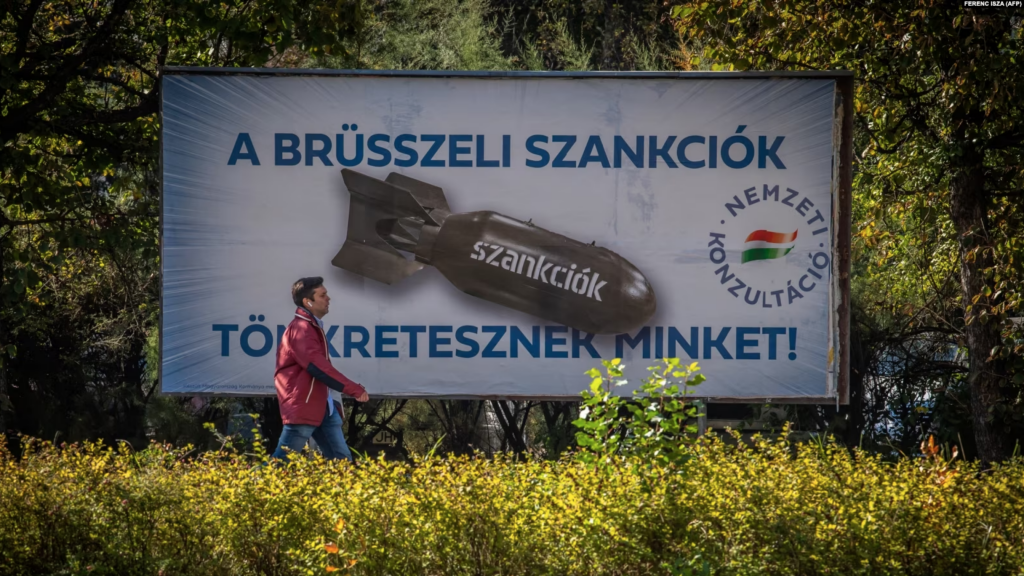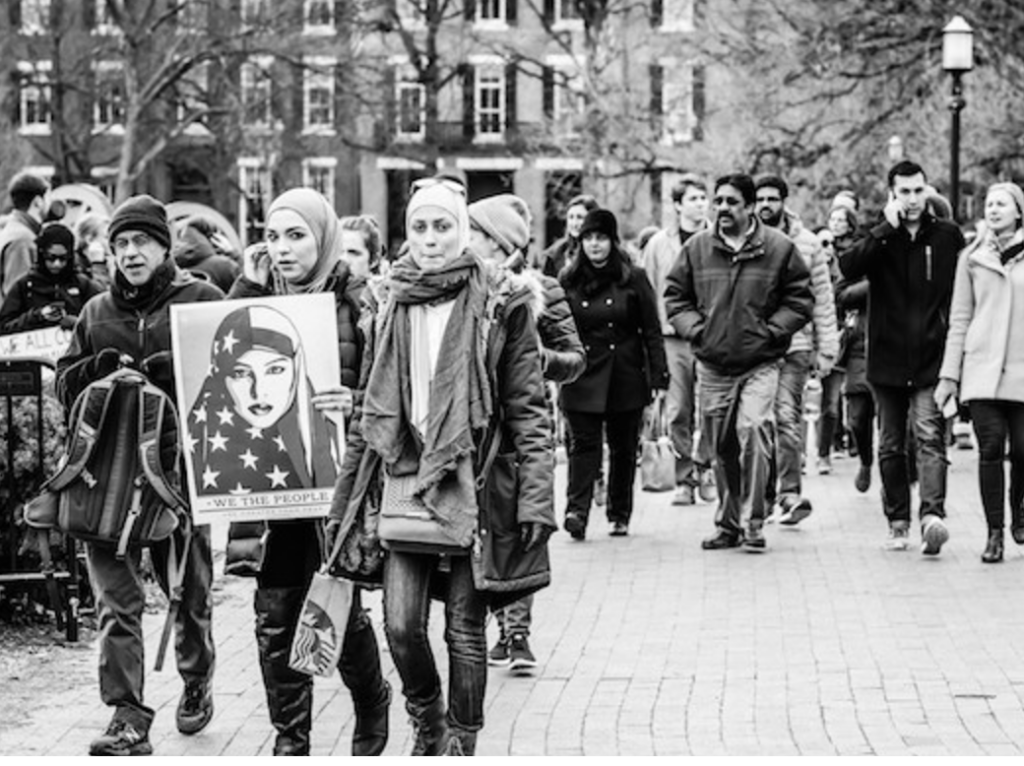The Jordan Center stands with all the people of Ukraine, Russia, and the rest of the world who oppose the Russian invasion of Ukraine. See our statement here.
Above: Government billboard representing sanctions imposed by the EU on the Russian economy as bombs being dropped on Hungary in 2022. The billboard reads: "The sanctions of Brussels are destroying us!"
Szinan Radi is a Postdoctoral Researcher at the Jordan Center for the Advanced Study of Russia at New York University. His research considers state-society relations, everyday economic life, and the popular experience of early-communist rule in postwar Eastern Europe with a special focus on Hungary.
Hungary has used an outlying strategy toward Russia’s invasion of Ukraine within the EU and NATO. Since the outbreak of war, the Hungarian government has consistently objected to providing military aid to Ukraine to help the country defend itself from its Eastern aggressor. Hungary has also striven to use its power as an EU member state to minimize the breadth and effect of sanctions imposed on Russia by the EU. The Hungarian government has made it clear that, rather than arms, only "peace" can bring an end to the conflict. For more than a year now, Hungary’s communication has centered around this message exclusively.
Hungarian commentators wonder if Hungary’s strategy could help establish peace in Eastern Europe, while Western analysts are perplexed about Hungary’s "peace" policy. Both sets of observers confuse a political means with an end. Historical experience shows the potential ends to which "peace" has been used in present-day Hungary. This post builds on the insight that the example of the Korean War (1950-3) can illuminate the geopolitical ramifications of the war in Ukraine. This framing simultaneously offers insight into Hungary’s current "peace" strategy, which legitimates illiberalism at home while preparing Hungary for the geopolitical restructuring that Hungarian PM Viktor Orbán has forecasted for the 2030s.
The impact of the Korean War on Hungary
In June 1950, North Korea invaded South Korea with the Soviet Union at its side. In response, the US deployed military personnel to defend Southern territorial integrity and contain the spread of communism in East Asia. As the Soviet Union and its satellite states in Eastern Europe began to increase military expenditures—at the expense of consumption—in preparation for a Third World War between East and West, the Soviet Union initiated a global program of peace propaganda. This program's goals were twofold: first, it aimed to wither Western societies’ consent to the West’s support of the war. Second, it sought to strengthen the legitimacy of the Soviet Union’s war effort on the home front. Eastern European states were quick to join this campaign.
In the early 1950s, as Hungary increased investments in heavy industry and military production according to Soviet expectations, living standards drastically diminished. By 1952, real wages were 18 per cent below the 1949 and 38 per cent below the 1938 levels. Like the Soviet Union, Stalinist Hungary adopted the propaganda of "peace" to legitimate the Soviet Union’s foreign policy and blame falling living standards on "Western aggression." According to communist guidelines, "peace" did not equate with pacifism. Instead, it entailed citizens’ self-sacrificing willingness to increase the country’s military potential against the backdrop of an imminent threat from the West.
In the early 1950s, Hungarian communists organized "peace marches" and forced citizens to sign the Stockholm Accord of nuclear disarmament, which they used to blame the West for warmongering. Moreover, each year between 1949 and 1955, via "peace committees" and even "peace priests," the Communist Party compelled citizens to forfeit two to four weeks' worth of their wages through "peace-loan" salary sacrifices to support the communist "peace camp," led by the Soviet Union, and to protect Hungary’s alleged postwar development and putatively rising living standards. Criticizing the official line in propaganda led to immediate reprisals. It was common practice, for instance, to publicly humiliate and incarcerate citizens on the pretext of being an enemy of "peace" and the "people."
"Peace" as a means of political mobilization in 2010s Hungary
After their landslide victory in 2010, the Hungarian ruling parties exploited "peace" for political mobilization at critical political junctures. Those in power have used this tactic to reinforce their domestic support and legitimate the government’s illiberal policy goals. Since 2012, government-funded "NGOs" organized peace marches in response to criticisms of Hungary's democratic deficiencies by Western (EU and US) and domestic "left-liberal" (One Million for the Freedom of Press movement; Milla) "enemies."
These peace marches positioned domestic and foreign enemies as national threat to Hungarian national security, stability, and welfare, blaming them for downturns in the Hungarian economy. The first three marches were held in 2012, when real wages decreased due to austerity measures the second Orbán government adopted in the wake of the 2008 financial crash, and when the government’s electoral support had started to diminish. Under the banner of "peace," the government wished to demonstrate its "moral superiority" against "enemy attacks" both at home and in the West.
After Russia’s invasion of Ukraine in February 2022, "peace" became a crucial component of the Hungarian ruling parties’ political strategy once again. Just as in the communist1950s, stigmatizing advocates of Ukraine's territorial integrity has become commonplace both on the Hungarian ("non-aligned") left and right. However, unlike after the Second World War, Hungary does not formally belong to the Russian sphere of interest. In fact, since 1999 and 2004, the country has been a member of NATO and the European Union, respectively.
What political goals could Hungary’s ruling parties hope to achieve through "peace" amid Europe’s worst inflationary pressure today—26.2 per cent compared to the 10 per cent EU average as of February 2023? The Korean War provides the lesson that shaping domestic and international public opinion cannot, on its own, lead to any satisfactory terms of exit from the war for any of the belligerent states, no matter what Hungary’s peace propaganda aims to suggest. It does, however, create a political milieu conducive to realizing certain policy goals for the donor parties of "peace" at home.
In the short run, therefore, the question mostly concerns the Hungarian government’s domestic and public policy objectives. The "politics of peace" is best conceived as a new stage in the Hungarian ruling parties’ political program of legitimating the "illiberal" model of state and social governance (Hungary, Russia) against its liberal (European Union, United States) competitor at home while strengthening the country’s economic ties with ideologically like-minded regimes like China—who also happen to challenge Western global supremacy.
In the long term, however, Hungary is preparing for a new world order. Orbán forecasts a Euro crisis for 2030 and a "very serious crisis" occurring in the United States "around the same time." These, according to him, will in turn alter global power structures as we know them today. Per Orbán, by 2030 Hungary will have become a net contributor to the EU—and, as he warns, "he who pays the piper calls the tune." Nonetheless, the political, economic and social dynamics, which had allowed the cyclical renewal of liberal democracies and market economies in the past, remain missing variables from predictive models of the Hungarian ruling parties’ "peace" policy.



